外研版(2019) 必修第二册 Unit 6 Earth First Listening & Speaking课件(38张)-
文档属性
| 名称 | 外研版(2019) 必修第二册 Unit 6 Earth First Listening & Speaking课件(38张)- |  | |
| 格式 | zip | ||
| 文件大小 | 11.4MB | ||
| 资源类型 | 教案 | ||
| 版本资源 | 外研版(2019) | ||
| 科目 | 英语 | ||
| 更新时间 | 2022-04-09 21:39:55 | ||
图片预览

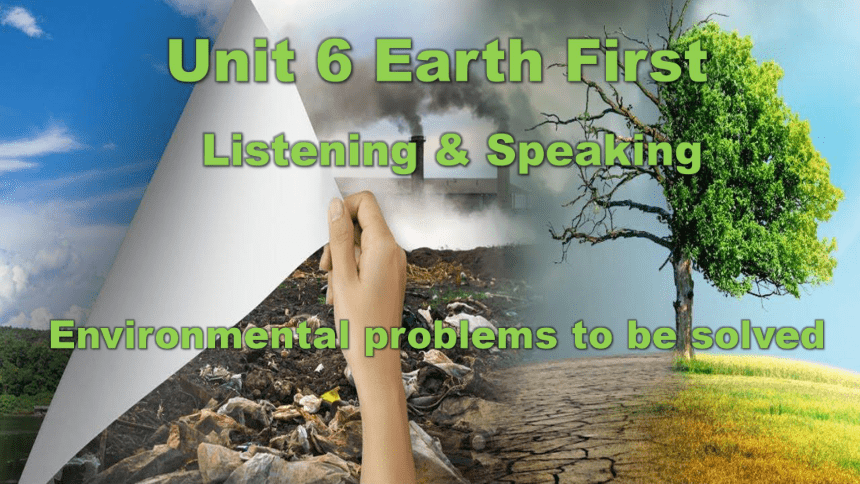
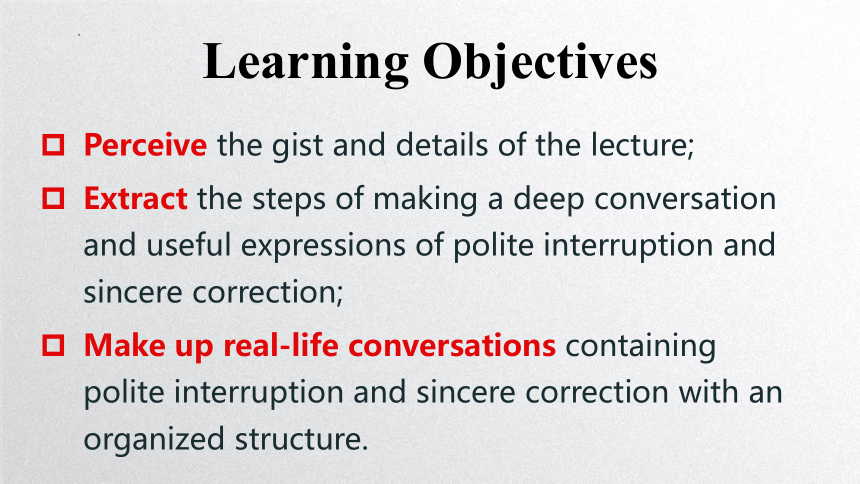



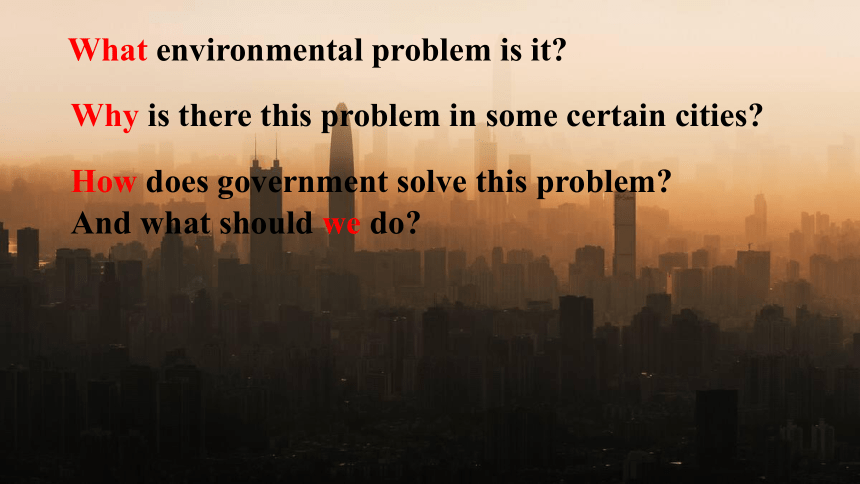

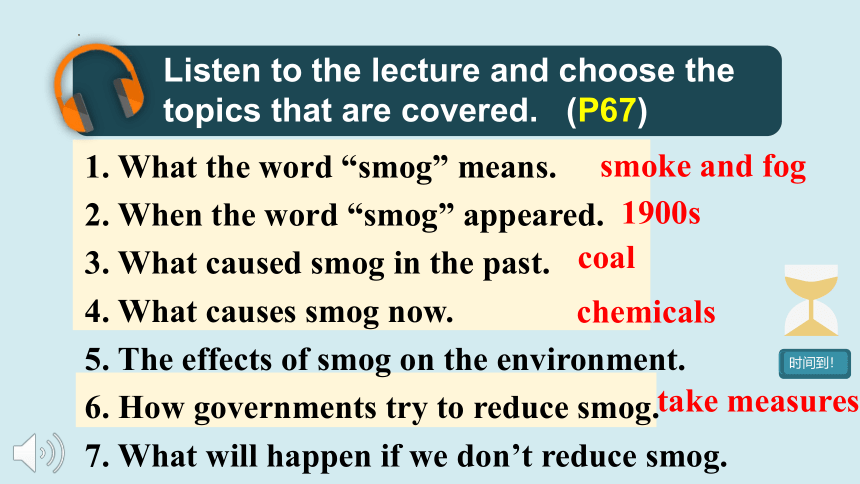
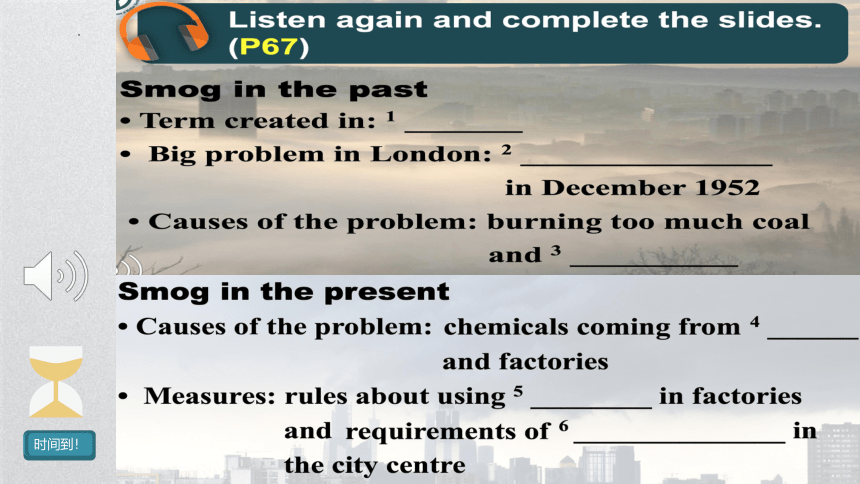
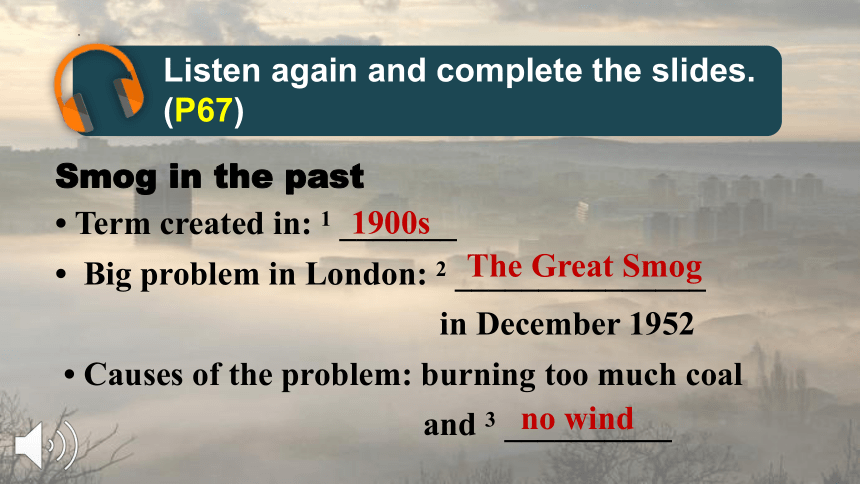
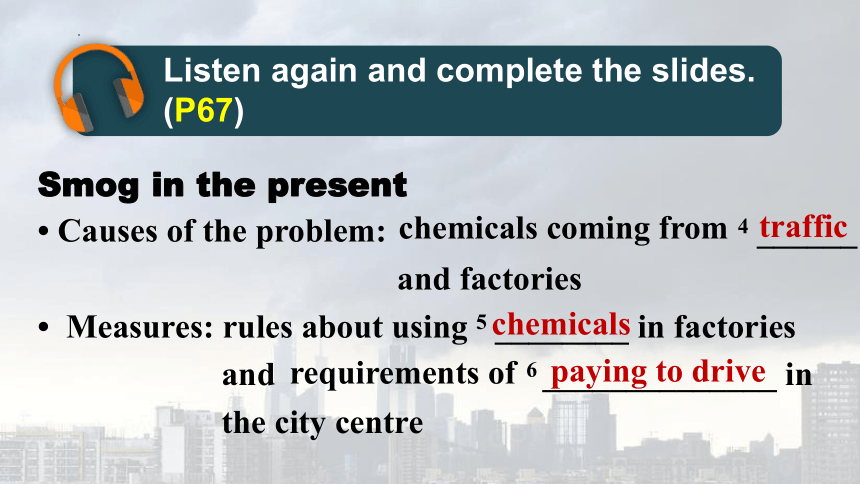
文档简介
(共38张PPT)
大观念视角下的单元整体学习
主题语境 “人与自然”——关爱地球、保护环境
正视环保问题
单元大观念:正视全球面临的环保问题,了解先进的环保理念,增强环保意识,践行绿色生活方式,树立共同关爱地球,保护环境,与自然和谐相处的价值观。
子主题
Period 1
Starting out & Vocabulary
感知环境问题;学习主题语块
把握主题,建立各语篇关联,形成大观念
Period 3
Using language: Grammar
关注海洋环境;聚焦人类活动
Period 4
Listening & Speaking
讨论雾霾污染;礼貌打断他人
增强环保意识
践行环保理念
Period 2
Understanding ideas
打破传统观念;重新认识鲨鱼
Period 5
Developing ideas
了解先进理念;真正绿色生活
Period 6
Writing
宣传光盘行动;环保共同参与
Period 7
Presenting ideas & Reflection
关注“碳足迹”;回顾单元内容
Unit 6 Earth First
Listening & Speaking
Environmental problems to be solved
Learning Objectives
Perceive the gist and details of the lecture;
Extract the steps of making a deep conversation and useful expressions of polite interruption and sincere correction;
Make up real-life conversations containing polite interruption and sincere correction with an organized structure.
What environmental problem is it
Why is there this problem in some certain cities
How does government solve this problem
And what should we do
Did You Know
Smog comes from the words “smoke” and “fog”, and it is used to describe the air pollution in cities caused mainly by traffic and factories. Smog can be dangerous because it causes severe breathing problems and infections.
Environmental problems to be solved
启动计时器
时间到!
Listen to the lecture and choose the topics that are covered. (P67)
1. What the word “smog” means.
2. When the word “smog” appeared.
3. What caused smog in the past.
4. What causes smog now.
5. The effects of smog on the environment.
6. How governments try to reduce smog.
7. What will happen if we don’t reduce smog.
smoke and fog
1900s
coal
chemicals
take measures
启动计时器
时间到!
启动计时器
时间到!
Listen again and complete the slides. (P67)
Smog in the past
Term created in: 1 _______
Big problem in London: 2 _______________
in December 1952
Causes of the problem: burning too much coal
and 3 __________
1900s
The Great Smog
no wind
Listen again and complete the slides. (P67)
Smog in the present
Causes of the problem: 4 ______
and factories
Measures: rules about using 5 ________ in factories
and 6 ______________ in
the city centre
chemicals coming from
chemicals
requirements of
traffic
paying to drive
problems
causes
measures
3 steps to make a deep conversation
what why how
Pragmatic function 语用功能
polite interruption
sincere correction
Learning to learn
A polite interruption is usually framed as a request for permission to interrupt someone, often starting with If ..., May I ... or Can I ... This may be preceded with an apology such as Sorry, ... or Excuse me, ... Usually we interrupt someone when they pause for breath, or during the slight pause between spoken clauses.
Useful expressions
Please feel free to stop me if you have any questions.
Sorry to interrupt, but ...
I'm afraid...
Excuse me, but can I just ask...
Is it OK if I jump in for a second
Well,...
Could I just stop you again to check ...
Sorry. I've made a mistake.
Do you mind if I ask another question
You're right, ...
Group the following sentences into the right section.
polite interruption
sincere correction
启动计时器
时间到!
Useful expressions
Please feel free to stop me if you have any questions.
Sorry. I've made a mistake.
You're right, ...
I'm afraid...
Well,...
Sorry to interrupt, but ...
Excuse me, but can I just ask...
Could I just stop you again to check ...
Do you mind if I ask another question
Sorry, but I was wondering whether ...
Is it OK if I jump in for a second
Group the following sentences into the right section.
polite interruption
sincere correction
Pair work
Talk about recycling
Student A: Turn to Page 84.
Student B: Turn to Page 87.
problems
causes
measures
Classification of household waste
Different types of waste can be disposed and recycled appropriately.
We can make full use of it to create value.
……
3 steps to make a deep conversation
what why how
Work in pairs and talk about recycling.
Useful expressions A
Please feel free to stop me if you have any questions.
Sorry, I`ve made a mistake.
You`re right…
I`m aftraid…
Well…
Useful expressions B
Sorry to interrupt, but…
Excuse me, but can I just ask…
Could I just stop you again to check…
Do you mind if I ask another question
Sorry, but I was wondering whether…
Is it OK if I jump in for a second
Student A
Tell student B about recycling using the information below.
Be prepared to be corrected by Student B.
1 The classification of household waste aims to help people separate different types of waste. This is important because these different types of waste can be disposed or recycled appropriately and effectively.
2 Household waste can be roughly divided into:
food waste, non-recyclable waste, and recyclable waste, including paper, glass, plastic and used batteries
3 China plans to introduce household waste classification and sorting in the first batch of cities by 2020. Only Beijing, Shanghai, Tianjin and Chongqing are included in the first batch.
4 The target recycling rate in these cities has been set at 55% by 2020
Student B
Listen to Student A talking about recycling. Interrupt politely to correct him/her using the following information:
1 Used batteries are usually regarded as non-recyclable waste and should be disposed of separately.
2 The first batch of cities to introduce household waste classification and sorting includes Beijing, Shanghai, Tianjin, Chongqing and all capitals of provinces and autonomous regions.
3 The target recycling rate in these cities has been set at 35% by 2020.
Evaluation Criteria Scale
involved 3 steps to make an integral conversation (problems—causes—measures) 1 2 3 4 5
made use of useful expressions and sentences that have the function of polite interruption and sincere correction 1 2 3 4 5
spoke loudly and clearly 1 2 3 4 5
spoke fluently 1 2 3 4 5
Assessment—价值与评判
Student A
Tell student B about recycling using the information below.
Be prepared to be corrected by Student B.
1 The classification of household waste aims to help people separate different types of waste. This is important because these different types of waste can be disposed or recycled appropriately and effectively.
2 Household waste can be roughly divided into:
food waste, non-recyclable waste, and recyclable waste, including paper, glass, plastic and used batteries
3 China plans to introduce household waste classification and sorting in the first batch of cities by 2020. Only Beijing, Shanghai, Tianjin and Chongqing are included in the first batch.
4 The target recycling rate in these cities has been set at 55% by 2020
Student B
Listen to Student A talking about recycling. Interrupt politely to correct him/her using the following information:
1 Used batteries are usually regarded as non-recyclable waste and should be disposed of separately.
2 The first batch of cities to introduce household waste classification and sorting includes Beijing, Shanghai, Tianjin, Chongqing and all capitals of provinces and autonomous regions.
3 The target recycling rate in these cities has been set at 35% by 2020.
启动计时器
时间到!
Student A
Tell student B about recycling using the information below.
Be prepared to be corrected by Student B.
1 The classification of household waste aims to help people separate different types of waste. This is important because these different types of waste can be disposed or recycled appropriately and effectively.
2 Household waste can be roughly divided into:
food waste, non-recyclable waste, and recyclable waste, including paper, glass, plastic and used batteries
3 China plans to introduce household waste classification and sorting in the first batch of cities by 2020. Only Beijing, Shanghai, Tianjin and Chongqing are included in the first batch.
4 The target recycling rate in these cities has been set at 55% by 2020
Student B
Listen to Student A talking about recycling. Interrupt politely to correct him/her using the following information:
1 Used batteries are usually regarded as non-recyclable waste and should be disposed of separately.
2 The first batch of cities to introduce household waste classification and sorting includes Beijing, Shanghai, Tianjin, Chongqing and all capitals of provinces and autonomous regions.
3 The target recycling rate in these cities has been set at 35% by 2020.
Possible version
1
A: Hey, xxx. Do you know anything about recycling It’s been a heated topic for a long time.
B: Yeah. One of it is the classification of household waste.
A: It is said that household waste can be roughly divided into three sorts, food waste, non-recyclable waste, and recyclable waste, including paper, glass, plastic and used batteries.
B: Sorry, could I stop you a little bit Used batteries are usually regarded as non-recyclable waste and should be disposed of separately.
A: Sorry, I’ve made a mistake. Besides that, China has made a plan for some metropolis to solve this environmental problem. Only Beijing, Shanghai, Tianjin and Chongqing are included in the first batch of cities by 2020.
B: Sorry, but I was wondering whether capitals of provinces and autonomous regions are also included.
A: Yeah, you are right. They all count. And do we need to recycle all of the waste I think the target recycling rate in these cities has been set at 55% by 2020.
B: Sorry to interrupt, but the rate should be 35% by 2020.
A: Well, let me see… Yeah, I’m afraid I got it wrong.
启动计时器
时间到!
Possible version
1
A: Hey, xxx. Do you know anything about recycling It’s been a heated topic for a long time.
B: Yeah. One of it is the classification of household waste.
A: Yeah, it aims to help people separate different types of waste. But why do we need to do so
B: I think it’s because if not, it would be hard for workers to dispose of or recycle different types of waste appropriately and effectively.
A: Oh, I get it. It is said that household waste can be roughly divided into three sorts, food waste, non-recyclable waste, and recyclable waste, including paper, glass, plastic and used batteries.
B: Sorry, could I stop you a little bit Used batteries are usually regarded as non-recyclable waste and should be disposed of separately.
A: Sorry, I’ve made a mistake. Besides that, China has made a plan for some metropolis to solve this environmental problem. Only Beijing, Shanghai, Tianjin and Chongqing are included in the first batch of cities by 2020.
B: Sorry, but I was wondering whether capitals of provinces and autonomous regions are also included.
A: Yeah, you are right. They all count. And do we need to recycle all of the waste I think the target recycling rate in these cities has been set at 55% by 2020.
B: Sorry to interrupt, but the rate should be 35% by 2020.
A: Well, let me see… Yeah, I’m afraid I got it wrong.
cause
Possible version
2
A: Hey, xxx. Do you know anything about recycling It’s been a heated topic for a long time.
B: Yeah. One of it is the classification of household waste.
A: Yeah, it aims to help people separate different types of waste. But why do we need to do so
B: I think it’s because if not, it would be hard for workers to dispose of or recycle different types of waste appropriately and effectively.
A: Oh, I get it. It is said that household waste can be roughly divided into three sorts, food waste, non-recyclable waste, and recyclable waste, including paper, glass, plastic and used batteries.
B: Seriously I do think you are wrong. Used batteries are usually regarded as non-recyclable waste and should be disposed of separately.
A: Sorry, I’ve made a mistake. Besides that, China has made a plan for some metropolis to solve this environmental problem. Only Beijing, Shanghai, Tianjin and Chongqing are included in the first batch of cities by 2020.
B: Sorry, but I was wondering whether capitals of provinces and autonomous regions are also included.
A: Yeah, you are right. They all count. And do we need to recycle all of the waste I think the target recycling rate in these cities has been set at 55% by 2020.
B: Sorry to interrupt, but the rate should be 35% by 2020.
A: Well, Jesus Christ. You almost made me insane …
启动计时器
时间到!
Possible version
2
A: Hey, xxx. Do you know anything about recycling It’s been a heated topic for a long time.
B: Yeah. One of it is the classification of household waste.
A: Yeah, it aims to help people separate different types of waste. But why do we need to do so
B: I think it’s because if not, it would be hard for workers to dispose of or recycle different types of waste appropriately and effectively.
A: Oh, I get it. It is said that household waste can be roughly divided into three sorts, food waste, non-recyclable waste, and recyclable waste, including paper, glass, plastic and used batteries.
B: Seriously I do think you are wrong. Used batteries are usually regarded as non-recyclable waste and should be disposed of separately.
A: Sorry, I’ve made a mistake. Besides that, China has made a plan for some metropolis to solve this environmental problem. Only Beijing, Shanghai, Tianjin and Chongqing are included in the first batch of cities by 2020.
B: Sorry, but I was wondering whether capitals of provinces and autonomous regions are also included.
A: Yeah, you are right. They all count. And do we need to recycle all of the waste I think the target recycling rate in these cities has been set at 55% by 2020.
B: Sorry to interrupt, but the rate should be 35% by 2020.
A: Well, Jesus Christ. You almost made me insane …
polite interruption
sincere correction
What environmental problem is it
Why is there this problem
in some certain cities
How does government solve this problem
And what should we do
肺部健康问题
哮喘
较低的预期寿命
眼睛的刺激
天生缺陷
对动植物的影响
Homework
Find a partner and try to list as many green lifestyles as you can.
If you think your partner’s opinion is not correct, you can argue with him or her with polite interruption and sincere correction.
Evaluation Criteria Scale
list at least 5 green lifestyles 1 2 3 4 5
make use of useful expressions and sentences that have the function of polite interruption and sincere correction 1 2 3 4 5
speak loudly and clearly 1 2 3 4 5
speak fluently 1 2 3 4 5
Assessment—价值与评判
Environmental problems
to be solved
have been solved
Thanks for your listening!
大观念视角下的单元整体学习
主题语境 “人与自然”——关爱地球、保护环境
正视环保问题
单元大观念:正视全球面临的环保问题,了解先进的环保理念,增强环保意识,践行绿色生活方式,树立共同关爱地球,保护环境,与自然和谐相处的价值观。
子主题
Period 1
Starting out & Vocabulary
感知环境问题;学习主题语块
把握主题,建立各语篇关联,形成大观念
Period 3
Using language: Grammar
关注海洋环境;聚焦人类活动
Period 4
Listening & Speaking
讨论雾霾污染;礼貌打断他人
增强环保意识
践行环保理念
Period 2
Understanding ideas
打破传统观念;重新认识鲨鱼
Period 5
Developing ideas
了解先进理念;真正绿色生活
Period 6
Writing
宣传光盘行动;环保共同参与
Period 7
Presenting ideas & Reflection
关注“碳足迹”;回顾单元内容
Unit 6 Earth First
Listening & Speaking
Environmental problems to be solved
Learning Objectives
Perceive the gist and details of the lecture;
Extract the steps of making a deep conversation and useful expressions of polite interruption and sincere correction;
Make up real-life conversations containing polite interruption and sincere correction with an organized structure.
What environmental problem is it
Why is there this problem in some certain cities
How does government solve this problem
And what should we do
Did You Know
Smog comes from the words “smoke” and “fog”, and it is used to describe the air pollution in cities caused mainly by traffic and factories. Smog can be dangerous because it causes severe breathing problems and infections.
Environmental problems to be solved
启动计时器
时间到!
Listen to the lecture and choose the topics that are covered. (P67)
1. What the word “smog” means.
2. When the word “smog” appeared.
3. What caused smog in the past.
4. What causes smog now.
5. The effects of smog on the environment.
6. How governments try to reduce smog.
7. What will happen if we don’t reduce smog.
smoke and fog
1900s
coal
chemicals
take measures
启动计时器
时间到!
启动计时器
时间到!
Listen again and complete the slides. (P67)
Smog in the past
Term created in: 1 _______
Big problem in London: 2 _______________
in December 1952
Causes of the problem: burning too much coal
and 3 __________
1900s
The Great Smog
no wind
Listen again and complete the slides. (P67)
Smog in the present
Causes of the problem: 4 ______
and factories
Measures: rules about using 5 ________ in factories
and 6 ______________ in
the city centre
chemicals coming from
chemicals
requirements of
traffic
paying to drive
problems
causes
measures
3 steps to make a deep conversation
what why how
Pragmatic function 语用功能
polite interruption
sincere correction
Learning to learn
A polite interruption is usually framed as a request for permission to interrupt someone, often starting with If ..., May I ... or Can I ... This may be preceded with an apology such as Sorry, ... or Excuse me, ... Usually we interrupt someone when they pause for breath, or during the slight pause between spoken clauses.
Useful expressions
Please feel free to stop me if you have any questions.
Sorry to interrupt, but ...
I'm afraid...
Excuse me, but can I just ask...
Is it OK if I jump in for a second
Well,...
Could I just stop you again to check ...
Sorry. I've made a mistake.
Do you mind if I ask another question
You're right, ...
Group the following sentences into the right section.
polite interruption
sincere correction
启动计时器
时间到!
Useful expressions
Please feel free to stop me if you have any questions.
Sorry. I've made a mistake.
You're right, ...
I'm afraid...
Well,...
Sorry to interrupt, but ...
Excuse me, but can I just ask...
Could I just stop you again to check ...
Do you mind if I ask another question
Sorry, but I was wondering whether ...
Is it OK if I jump in for a second
Group the following sentences into the right section.
polite interruption
sincere correction
Pair work
Talk about recycling
Student A: Turn to Page 84.
Student B: Turn to Page 87.
problems
causes
measures
Classification of household waste
Different types of waste can be disposed and recycled appropriately.
We can make full use of it to create value.
……
3 steps to make a deep conversation
what why how
Work in pairs and talk about recycling.
Useful expressions A
Please feel free to stop me if you have any questions.
Sorry, I`ve made a mistake.
You`re right…
I`m aftraid…
Well…
Useful expressions B
Sorry to interrupt, but…
Excuse me, but can I just ask…
Could I just stop you again to check…
Do you mind if I ask another question
Sorry, but I was wondering whether…
Is it OK if I jump in for a second
Student A
Tell student B about recycling using the information below.
Be prepared to be corrected by Student B.
1 The classification of household waste aims to help people separate different types of waste. This is important because these different types of waste can be disposed or recycled appropriately and effectively.
2 Household waste can be roughly divided into:
food waste, non-recyclable waste, and recyclable waste, including paper, glass, plastic and used batteries
3 China plans to introduce household waste classification and sorting in the first batch of cities by 2020. Only Beijing, Shanghai, Tianjin and Chongqing are included in the first batch.
4 The target recycling rate in these cities has been set at 55% by 2020
Student B
Listen to Student A talking about recycling. Interrupt politely to correct him/her using the following information:
1 Used batteries are usually regarded as non-recyclable waste and should be disposed of separately.
2 The first batch of cities to introduce household waste classification and sorting includes Beijing, Shanghai, Tianjin, Chongqing and all capitals of provinces and autonomous regions.
3 The target recycling rate in these cities has been set at 35% by 2020.
Evaluation Criteria Scale
involved 3 steps to make an integral conversation (problems—causes—measures) 1 2 3 4 5
made use of useful expressions and sentences that have the function of polite interruption and sincere correction 1 2 3 4 5
spoke loudly and clearly 1 2 3 4 5
spoke fluently 1 2 3 4 5
Assessment—价值与评判
Student A
Tell student B about recycling using the information below.
Be prepared to be corrected by Student B.
1 The classification of household waste aims to help people separate different types of waste. This is important because these different types of waste can be disposed or recycled appropriately and effectively.
2 Household waste can be roughly divided into:
food waste, non-recyclable waste, and recyclable waste, including paper, glass, plastic and used batteries
3 China plans to introduce household waste classification and sorting in the first batch of cities by 2020. Only Beijing, Shanghai, Tianjin and Chongqing are included in the first batch.
4 The target recycling rate in these cities has been set at 55% by 2020
Student B
Listen to Student A talking about recycling. Interrupt politely to correct him/her using the following information:
1 Used batteries are usually regarded as non-recyclable waste and should be disposed of separately.
2 The first batch of cities to introduce household waste classification and sorting includes Beijing, Shanghai, Tianjin, Chongqing and all capitals of provinces and autonomous regions.
3 The target recycling rate in these cities has been set at 35% by 2020.
启动计时器
时间到!
Student A
Tell student B about recycling using the information below.
Be prepared to be corrected by Student B.
1 The classification of household waste aims to help people separate different types of waste. This is important because these different types of waste can be disposed or recycled appropriately and effectively.
2 Household waste can be roughly divided into:
food waste, non-recyclable waste, and recyclable waste, including paper, glass, plastic and used batteries
3 China plans to introduce household waste classification and sorting in the first batch of cities by 2020. Only Beijing, Shanghai, Tianjin and Chongqing are included in the first batch.
4 The target recycling rate in these cities has been set at 55% by 2020
Student B
Listen to Student A talking about recycling. Interrupt politely to correct him/her using the following information:
1 Used batteries are usually regarded as non-recyclable waste and should be disposed of separately.
2 The first batch of cities to introduce household waste classification and sorting includes Beijing, Shanghai, Tianjin, Chongqing and all capitals of provinces and autonomous regions.
3 The target recycling rate in these cities has been set at 35% by 2020.
Possible version
1
A: Hey, xxx. Do you know anything about recycling It’s been a heated topic for a long time.
B: Yeah. One of it is the classification of household waste.
A: It is said that household waste can be roughly divided into three sorts, food waste, non-recyclable waste, and recyclable waste, including paper, glass, plastic and used batteries.
B: Sorry, could I stop you a little bit Used batteries are usually regarded as non-recyclable waste and should be disposed of separately.
A: Sorry, I’ve made a mistake. Besides that, China has made a plan for some metropolis to solve this environmental problem. Only Beijing, Shanghai, Tianjin and Chongqing are included in the first batch of cities by 2020.
B: Sorry, but I was wondering whether capitals of provinces and autonomous regions are also included.
A: Yeah, you are right. They all count. And do we need to recycle all of the waste I think the target recycling rate in these cities has been set at 55% by 2020.
B: Sorry to interrupt, but the rate should be 35% by 2020.
A: Well, let me see… Yeah, I’m afraid I got it wrong.
启动计时器
时间到!
Possible version
1
A: Hey, xxx. Do you know anything about recycling It’s been a heated topic for a long time.
B: Yeah. One of it is the classification of household waste.
A: Yeah, it aims to help people separate different types of waste. But why do we need to do so
B: I think it’s because if not, it would be hard for workers to dispose of or recycle different types of waste appropriately and effectively.
A: Oh, I get it. It is said that household waste can be roughly divided into three sorts, food waste, non-recyclable waste, and recyclable waste, including paper, glass, plastic and used batteries.
B: Sorry, could I stop you a little bit Used batteries are usually regarded as non-recyclable waste and should be disposed of separately.
A: Sorry, I’ve made a mistake. Besides that, China has made a plan for some metropolis to solve this environmental problem. Only Beijing, Shanghai, Tianjin and Chongqing are included in the first batch of cities by 2020.
B: Sorry, but I was wondering whether capitals of provinces and autonomous regions are also included.
A: Yeah, you are right. They all count. And do we need to recycle all of the waste I think the target recycling rate in these cities has been set at 55% by 2020.
B: Sorry to interrupt, but the rate should be 35% by 2020.
A: Well, let me see… Yeah, I’m afraid I got it wrong.
cause
Possible version
2
A: Hey, xxx. Do you know anything about recycling It’s been a heated topic for a long time.
B: Yeah. One of it is the classification of household waste.
A: Yeah, it aims to help people separate different types of waste. But why do we need to do so
B: I think it’s because if not, it would be hard for workers to dispose of or recycle different types of waste appropriately and effectively.
A: Oh, I get it. It is said that household waste can be roughly divided into three sorts, food waste, non-recyclable waste, and recyclable waste, including paper, glass, plastic and used batteries.
B: Seriously I do think you are wrong. Used batteries are usually regarded as non-recyclable waste and should be disposed of separately.
A: Sorry, I’ve made a mistake. Besides that, China has made a plan for some metropolis to solve this environmental problem. Only Beijing, Shanghai, Tianjin and Chongqing are included in the first batch of cities by 2020.
B: Sorry, but I was wondering whether capitals of provinces and autonomous regions are also included.
A: Yeah, you are right. They all count. And do we need to recycle all of the waste I think the target recycling rate in these cities has been set at 55% by 2020.
B: Sorry to interrupt, but the rate should be 35% by 2020.
A: Well, Jesus Christ. You almost made me insane …
启动计时器
时间到!
Possible version
2
A: Hey, xxx. Do you know anything about recycling It’s been a heated topic for a long time.
B: Yeah. One of it is the classification of household waste.
A: Yeah, it aims to help people separate different types of waste. But why do we need to do so
B: I think it’s because if not, it would be hard for workers to dispose of or recycle different types of waste appropriately and effectively.
A: Oh, I get it. It is said that household waste can be roughly divided into three sorts, food waste, non-recyclable waste, and recyclable waste, including paper, glass, plastic and used batteries.
B: Seriously I do think you are wrong. Used batteries are usually regarded as non-recyclable waste and should be disposed of separately.
A: Sorry, I’ve made a mistake. Besides that, China has made a plan for some metropolis to solve this environmental problem. Only Beijing, Shanghai, Tianjin and Chongqing are included in the first batch of cities by 2020.
B: Sorry, but I was wondering whether capitals of provinces and autonomous regions are also included.
A: Yeah, you are right. They all count. And do we need to recycle all of the waste I think the target recycling rate in these cities has been set at 55% by 2020.
B: Sorry to interrupt, but the rate should be 35% by 2020.
A: Well, Jesus Christ. You almost made me insane …
polite interruption
sincere correction
What environmental problem is it
Why is there this problem
in some certain cities
How does government solve this problem
And what should we do
肺部健康问题
哮喘
较低的预期寿命
眼睛的刺激
天生缺陷
对动植物的影响
Homework
Find a partner and try to list as many green lifestyles as you can.
If you think your partner’s opinion is not correct, you can argue with him or her with polite interruption and sincere correction.
Evaluation Criteria Scale
list at least 5 green lifestyles 1 2 3 4 5
make use of useful expressions and sentences that have the function of polite interruption and sincere correction 1 2 3 4 5
speak loudly and clearly 1 2 3 4 5
speak fluently 1 2 3 4 5
Assessment—价值与评判
Environmental problems
to be solved
have been solved
Thanks for your listening!
